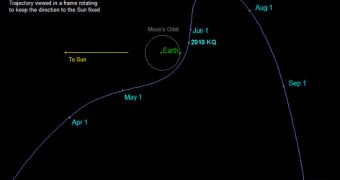In early May, astronomers discovered that a bizarre object was heading for Earth. They were not alarmed because it appeared to be very small, and therefore posed no significant danger for our planet. After it zoomed past, experts were finally able to identify its origin. They now say that the interesting object was in fact a wayward piece of space junk, and not a small asteroid. NASA officials announced yesterday (May 28), that the debris was most likely produced by a former interplanetary mission the space agency launched, Space reports.
The object passed through its point of closest approach on May 21, when it reached as close as the orbit of the Moon. The planet's natural satellite is located about 384,402 kilometers (238,900 miles) away from Earth, so the distance was fairly small. According to recent readings, taken in subsequent days, the piece of junk is currently heading even further into space, away from Earth. It will most likely be captured on an orbit through the solar system, which will make it behave like a comet, or maybe get attracted by massive planets such as Jupiter and Saturn.
“The orbit of this object is very similar to that of the Earth, and one would not expect an object to remain in this type of orbit for very long,” explains NASA scientist Paul Chodas. He holds an appointment at the Near-Earth Object Program Office, which is located at the Pasadena, California-based Jet Propulsion Laboratory (JPL). This particular piece of space junk, which most likely came from a past rocket launched, was dubbed 2010 KQ. The object was most likely no large than a few meters in diameter, the JPL team says.
“At present, there is a 6 percent probability that 2010 KQ will enter our atmosphere over a 30-year period starting in 2036. More than likely, additional observations of the object will refine its orbit and impact possibilities. Even in the unlikely event that this object is headed for impact with Earth, whether it is an asteroid or rocket body, it is so small that it would disintegrate in the atmosphere and not cause harm on the ground,” Chodas explains in the same statement.

 14 DAY TRIAL //
14 DAY TRIAL //